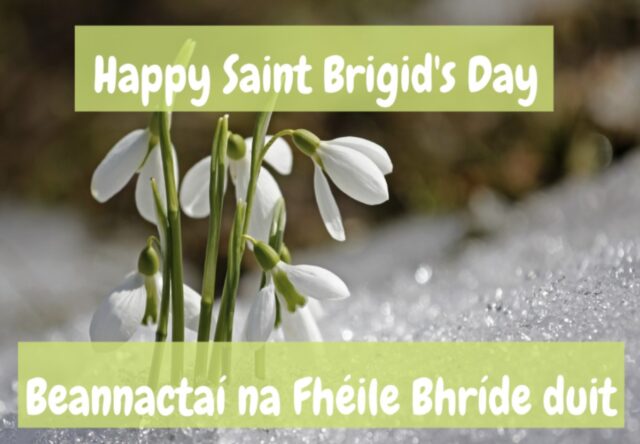This week we reach the midpoint of winter, marked by the cross-quarter day of Imbolc.
Traditionally, Imbolc begins at sundown on February 1 and continues through February 2.
Imbolc is an ancient Celtic holiday celebrating the very first stirrings of new life, the earliest breaths of spring.
We are beginning to feel the very earliest hints of spring rising in our spirits.
After months of turning inward, of hibernation and of rest, life is beginning to stir again.
Spiritually, this is a time of new life coming into manifestation.
We may only be seeing the tiniest hints of life above the surface but things are really beginning to stir in the darkness.
We are about to begin a new season of promised hope and light. February is a most hopeful month.
This week we celebrate St Brigid’s Day, a day which brings great hope. St Brigid brings with her a story of compassion, generosity, healing and renewal.
These early February days mark the beginning of Spring. Yes, it may still feel cold but already brighter evenings, emerging green shoots and snowdrops, announce a time for new beginnings.
I’m glad the darkness of winter once again is being transformed by the light of our new spring.
Spring is a season of Hope and renewal. We are in the true sense of Scripture called out of darkness into God’s wonderful light.
I love this time of year, a time to embrace brighter evenings and early mornings.
Already there are signs of the new spring. Snowdrops, emerging from the winter soil.
I’m absolutely delighted that on Monday, February 6, our Country celebrates a national holiday, attributed to an iconic and important lady, Saint Brigid of Kildare.
Children in primary schools, learn the hopeful melody, Saint Brigid brings the spring.
I pray that this new season of hope, when green things re-emerge, will be a time of rejuvenation for us all.
Brigid was whole-hearted in the ministry of helping people in need, convinced of the principle that “the measure you give will be the measure you get back.”
Born at Faughart, near Dundalk, County Louth, in the middle of the 5th century, probably in the latter years of Saint Patrick’s ministry in Ireland, Brigid refused several offers of marriage, in order to become a nun in the service of Christ and his church.
With seven other young women she settled for a time at the foot of Croghan Hill, but moved then to the plains of the Liffey Valley, where under a large oak tree she erected her famous convent of Cill-Dara, that is, “the church of the oak” (now Kildare).
She died there half a century later, on February 1, 525.
The most ancient life of St Brigid is by Broccan, (d. 650). Then the “Second Life” was composed in the 8th century by Cogitosus, a monk of Kildare.
An interesting feature of this work is his description of the Cathedral of Kildare, whose Round Tower may date back to the sixth or seventh century.
Brigid’s strong personality and example ensured that her community served their neighbours, through various acts of mercy.
Soon her small oratory at Cill-Dara (the chapel-at-the-oak) became a centre of religion and learning, and later developed into a small city.
She founded two monastic institutions, one for men, and the other for women, and apparently held jurisdiction over both of them.
According to her biographer, she chose St Conleth “to govern the church along with herself.”
For centuries, Kildare was ruled by a double line of abbot-bishops and abbesses, the abbess of Kildare being the leader of all the convents in Ireland.
During the raids by the Norsemen in the 9th century, Brigid’s relics were taken for safety to Downpatrick, where they were interred in the tomb of St Patrick and St Columcille, and since 1190 they rest in Downpatrick Cathedral.
The three; Patrick, Brigid and Columcille, have for centuries been regarded as the three main patron saints of Ireland.
Even after 1500 years, the iconic Brigid, known as Mary of the Gael, is very dear to Irish hearts, and Brigid, Breege or “Bridie” preponderates as a female Christian name.
Hundreds of place-names in her honour are to be found all over the country, e.g. Kilbride, Brideswell, Tubberbride, Templebride, etc. While her main monument is in Kildare town, she is also keenly remembered in her birthplace at Faughart, in County Louth.
The old St Brigid’s well adjoining the ruined church there dates from antiquity and still attracts pilgrims today.
May we all indulge in the well springs of Brigid. May this great Lady, bring rich blessings of health and peace to all our families.
St Bridget’s Well (a poem from point of view of a pilgrim to the shrine)
We set out this night toward the well of St. Brigid, sailing from the island of Innis Oirr.
Then by foot on through Doolin to follow that trail that skirts the sheer drop off the Cliffs of Mohar.
Then we scrabble the Burren over rock walls and pastures to a foothill of magic in the County of Clare,
Where a spring of cold water runs through a cold cave and the water is wishes from the wells of our hearts,
That the ones that we love might be plucked from their sickness or freed from despair so the healing might start.






















